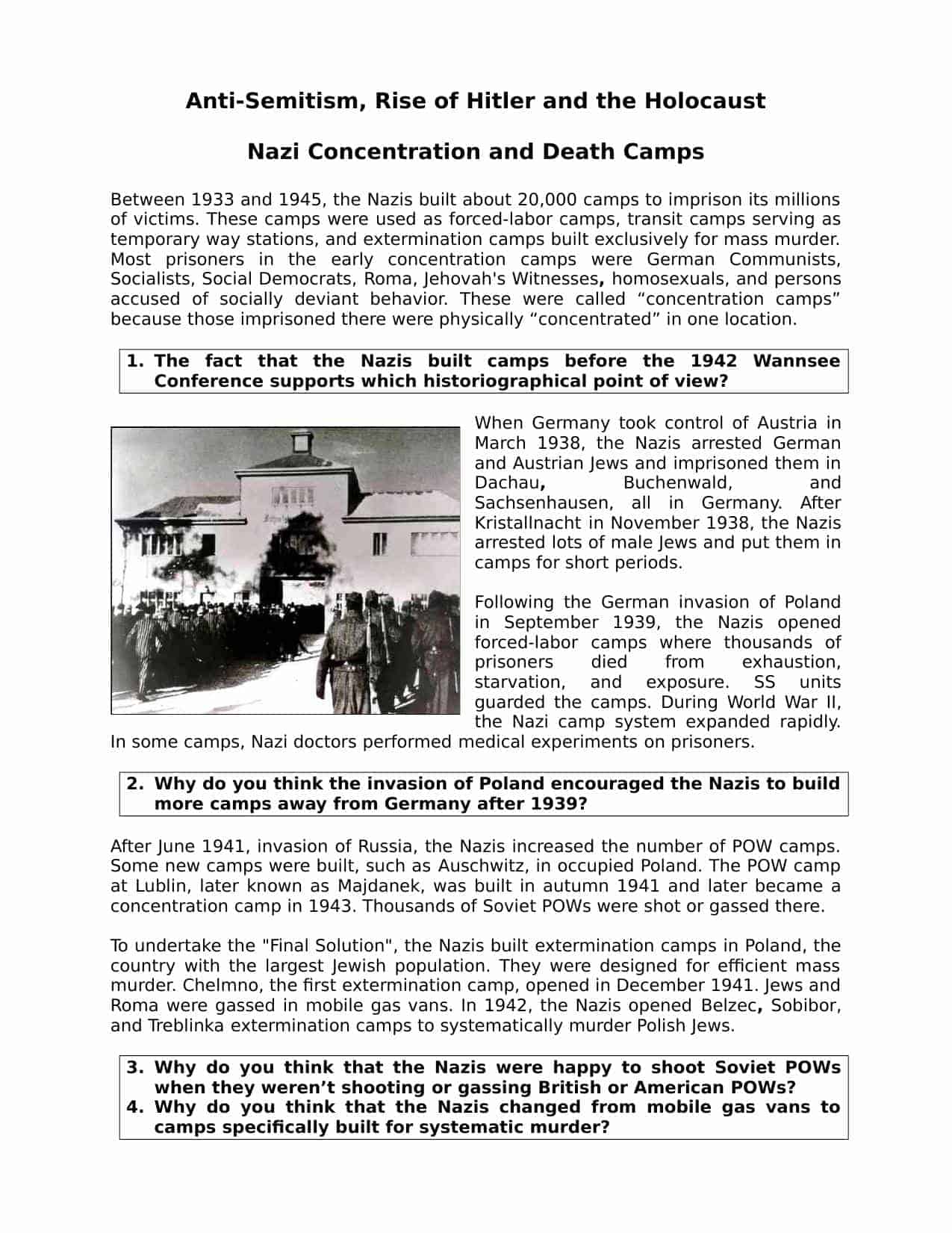Download Nazi Concentration and Death Camps
Click the button below to download this worksheet for use in the classroom or at home.
Download →
Lesson Plan Snapshot:
Between 1933 and 1945, the Nazis built about 20,000 camps to imprison its millions of victims. These camps were used as forced-labor camps, transit camps serving as temporary way stations, and extermination camps built exclusively for mass murder. Most prisoners in the early concentration camps were German Communists, Socialists, Social Democrats, Roma, Jehovah’s Witnesses, homosexuals, and persons accused of socially deviant behavior. These were called “concentration camps” because those imprisoned there were physically “concentrated” in one location.
When Germany took control of Austria in March 1938, the Nazis arrested German and Austrian Jews and imprisoned them in Dachau, Buchenwald, and Sachsenhausen, all in Germany. After Kristallnacht in November 1938, the Nazis arrested lots of male Jews and put them in camps for short periods.
Following the German invasion of Poland in September 1939, the Nazis opened forced-labor camps where thousands of prisoners died from exhaustion, starvation, and exposure. SS units guarded the camps. During World War II, the Nazi camp system expanded rapidly. In some camps, Nazi doctors performed medical experiments on prisoners.
After June 1941, invasion of Russia, the Nazis increased the number of POW camps. Some new camps were built, such as Auschwitz, in occupied Poland. The POW camp at Lublin, later known as Majdanek, was built in autumn 1941 and later became a concentration camp in 1943. Thousands of Soviet POWs were shot or gassed there.
To undertake the “Final Solution”, the Nazis built extermination camps in Poland, the country with the largest Jewish population. They were designed for efficient mass murder. Chelmno, the first extermination camp, opened in December 1941. Jews and Roma were gassed in mobile gas vans. In 1942, the Nazis opened Belzec, Sobibor, and Treblinka extermination camps to systematically murder Polish Jews.
Gas Chambers:
The Nazis built gas chambers to increase killing efficiency and to make the process more impersonal for the killers. At the Auschwitz, the Birkenau extermination camp had 4 gas chambers. Up to 6,000 Jews were gassed there each day.
Jews in Nazi-occupied lands often were first sent to transit camps such as Westerbork in the Netherlands en route to the killing centers in occupied Poland. The transit camps were usually the last stop before the extermination camp.
Millions of people were imprisoned and abused in different types of Nazi camps. Under SS management, the Germans and their supporters murdered more than 3 million Jews in the camps alone. Only a small portion of those imprisoned in Nazi camps survived.
Killing centers:
The Nazis established killing centers for efficient mass murder. Unlike concentration camps, which served primarily as detention and labor centers, extermination or death camps were almost exclusively “death factories.” German SS and police murdered nearly 2,700,000 Jews in the killing centers either by asphyxiation with poison gas or by shooting.
The first killing center was Chelmno, which opened in the Warthegau (part of Poland annexed to Germany) in December 1941. Mostly Jews, but also Roma, were gassed in mobile gas vans there. In 1942 the Nazis opened the Belzec, Sobibor, and Treblinka killing centers to systematically murder Polish Jews. The SS killed approximately 1,526,500 Jews between March 1942 and November 1943.
Almost all of the deportees who arrived at the camps were sent immediately to death in the gas chambers (with the exception of Jews chosen for the Sonderkommandos). The largest killing center was Auschwitz-Birkenau, which by spring 1943 had four gas chambers using Zyklon B poison gas. At the height of the deportations, up to 6,000 Jews were gassed each day at Auschwitz-Birkenau in Poland. Over a million Jews and tens of thousands of Roma, Poles, and Soviet prisoners of war were killed there by November 1944.
Though many scholars have traditionally counted the Majdanek camp as a sixth killing center, recent research had shed more light on the functions and operations at Lublin/Majdanek. Within the framework of Operation Reinhard, Majdanek primarily served to concentrate Jews whom the Germans spared temporarily for forced labor. It occasionally functioned as a killing site to murder victims who could not be killed at the Operation Reinhard killing centers: Belzec, Sobibor, and Treblinka II. It also contained a storage depot for property and valuables taken from the Jewish victims at the killing centers.
The SS considered the killing centers top secret. To erase all traces of gassing operations, special prisoner units (Sonderkommandos) were forced to remove corpses from the gas chambers and cremate them. The grounds of some killing centers were re-landscaped or camouflaged to disguise the murder of millions.
Worksheet Lesson Plan:
- Aimed at Students studying across UK Year 7,8 & 9 or equivalent
- Premium resource
- Use as you wish in the classroom or home environment
- Structured information sheet.
- Includes 8 challenging questions.
- In-depth write up on Nazi concentration camps.
